How To Install Apache Tomcat 9.0 / 8.5 on CentOS 7 / RHEL 7
Apache Tomcat is an open source web server and servlet container developed by the Apache Software Foundation (ASF). Tomcat implements the Java Servlet and the JavaServer Pages (JSP) specifications from Oracle and provides a “pure Java” HTTP web server environment for running the Java codes.
Apache Tomcat includes tools for configuration and management, but it can also be configured by editing XML configuration files.
Here is the step by step guide to install Apache Tomcat 9.0 / 8.5 on RHEL 7 / CentOS 7.
Prerequisites
Open a terminal and switch to root user.
su -
Tomcat requires having java installed on your machine. You can install either Oracle JDK or OpenJDK.
READ: How to Install Oracle JAVA 8 on CentOS 7 / RHEL 7
For this post, I am using OpenJDK.
yum install -y java-1.8.0 wget
You can also verify it, by issuing the following command.
java -version
Output:
openjdk version "1.8.0_212" OpenJDK Runtime Environment (build 1.8.0_212-b04) OpenJDK 64-Bit Server VM (build 25.212-b04, mixed mode)
Create Tomcat Service Account
For best practice, Tomcat should not be run as root user. So, create a normal user for running the Tomcat service.
groupadd tomcat useradd -g tomcat -d /opt/tomcat -s /bin/nologin tomcat
Download & Setup Apache Tomcat
Download the latest version of the Apache Tomcat from the website and save it to your working directory.
Browser
Apache Tomcat 9:
Apache Tomcat 8.5:
Terminal
### Apache Tomcat 9.0 ### wget https://www-us.apache.org/dist/tomcat/tomcat-9/v9.0.19/bin/apache-tomcat-9.0.19.tar.gz ### Apache Tomcat 8.5 ### wget https://www-us.apache.org/dist/tomcat/tomcat-8/v8.5.40/bin/apache-tomcat-8.5.40.tar.gz
Extract the Tomcat archive and move it to your desired (/opt/tomcat) directory.
tar -zxvf apache-tomcat-*.tar.gz mv apache-tomcat-*/* /opt/tomcat/
Change the ownership of the directory so that tomcat user can write files in it.
chown -R tomcat:tomcat /opt/tomcat/
Start Apache Tomcat
Manual
Apache Tomcat can be started and stopped by the script which comes with the package. Start the Apache Tomcat.
cd /opt/tomcat/bin/ sh startup.sh
You will get the following output.
Using CATALINA_BASE: /opt/tomcat Using CATALINA_HOME: /opt/tomcat Using CATALINA_TMPDIR: /opt/tomcat/temp Using JRE_HOME: /usr Using CLASSPATH: /opt/tomcat/bin/bootstrap.jar:/opt/tomcat/bin/tomcat-juli.jar Tomcat started.
Stop the Apache Tomcat.
cd /opt/tomcat/bin/ sh shutdown.sh
Systemd
We can also configure systemd to start the Tomcat service. Skip the below step in case you do not want to use systemd for managing Tomcat service.
Tomcat’s systemd service file requires java location. So, run the following command to list the java versions available on your system.
alternatives --list | grep ^java
Output:
java manual /usr/lib/jvm/java-1.8.0-openjdk-1.8.0.212.b04-0.el7_6.x86_64/jre/bin/java
At this time, I have Java 1.8 on my system.
Create a tomcat systemd service file. Green ones depend on the environment, so change them accordingly.
vi /etc/systemd/system/tomcat.service
Add below information to Tomcat systemd service file.
[Unit] Description=Apache Tomcat Web Application Container Wants=network.target After=network.target [Service] Type=forking Environment=JAVA_HOME=/usr/lib/jvm/java-1.8.0-openjdk-1.8.0.212.b04-0.el7_6.x86_64/ Environment=CATALINA_PID=/opt/tomcat/temp/tomcat.pid Environment=CATALINA_HOME=/opt/tomcat Environment='CATALINA_OPTS=-Xms512M -Xmx1G -Djava.net.preferIPv4Stack=true' Environment='JAVA_OPTS=-Djava.awt.headless=true' ExecStart=/opt/tomcat/bin/startup.sh ExecStop=/opt/tomcat/bin/shutdown.sh SuccessExitStatus=143 User=tomcat Group=tomcat UMask=0007 RestartSec=10 Restart=always [Install] WantedBy=multi-user.target
Reload systemd daemon.
systemctl daemon-reload
To start the Tomcat service; run:
systemctl start tomcat
Check the status of Tomcat, run:
systemctl status tomcat
Enable the auto start of Tomcat service on system start, run:
systemctl enable tomcat
Verify Apache Tomcat
By default, Tomcat runs on port no 8080. Use netstat command to check whether the service is listening on port 8080 or not.
netstat -antup | grep 8080
Output:
tcp6 0 0 :::8080 :::* LISTEN 2428/java
Firewall
You may need to allow port 8080 in the firewall so that we can access Tomcat from external networks.
firewall-cmd --permanent --add-port=8080/tcp firewall-cmd --reload
Configure Apache Tomcat Web UI
Tomcat can be managed through the Web Manager. With Web Manager, we can
- Deploy new application, deploy
- Deploy new application on the specified context
- List the active or inactive applications
- Start and stop the web applications
Also, Tomcat has Host Manager to manage its virtual hosts.
Both The Web and Host Manager is password protected, requires username and password to access. Only the user with the “manager-gui” and “admin-gui” role is allowed to access.
These users and roles are defined in tomcat-users.xml.
vi /opt/tomcat/conf/tomcat-users.xml
Place the following two lines just above the last line.
<role rolename="admin-gui,manager-gui"/> <user username="admin" password="tomcat" roles="manager-gui,admin-gui"/>
For security reason, Web and Host Manager is accessible only from localhost, i.e., from the server itself.
If you want to access Web and Host manager from remote systems, then you need to add your source network in allow list. To do that, edit the below two files.
vi /opt/tomcat/webapps/manager/META-INF/context.xml vi /opt/tomcat/webapps/host-manager/META-INF/context.xml
Update the below line on both files with source IP from which you’re accessing the Web and Host Manager. .* will allow everyone to have access to Web and Host manager.
allow="127\.\d+\.\d+\.\d+|::1|0:0:0:0:0:0:0:1|.*" />
OR
You can also allow part of your network only. For example: To allow 10.20.0.0/24 network only, you can use the below values.
allow="127\.\d+\.\d+\.\d+|::1|0:0:0:0:0:0:0:1|10.20.*" />
Restart the Tomcat service.
systemctl restart tomcat
Access Tomcat
Open the web browser and point to
You should now get the Tomcat’s default page.
Tomcat 9.0:
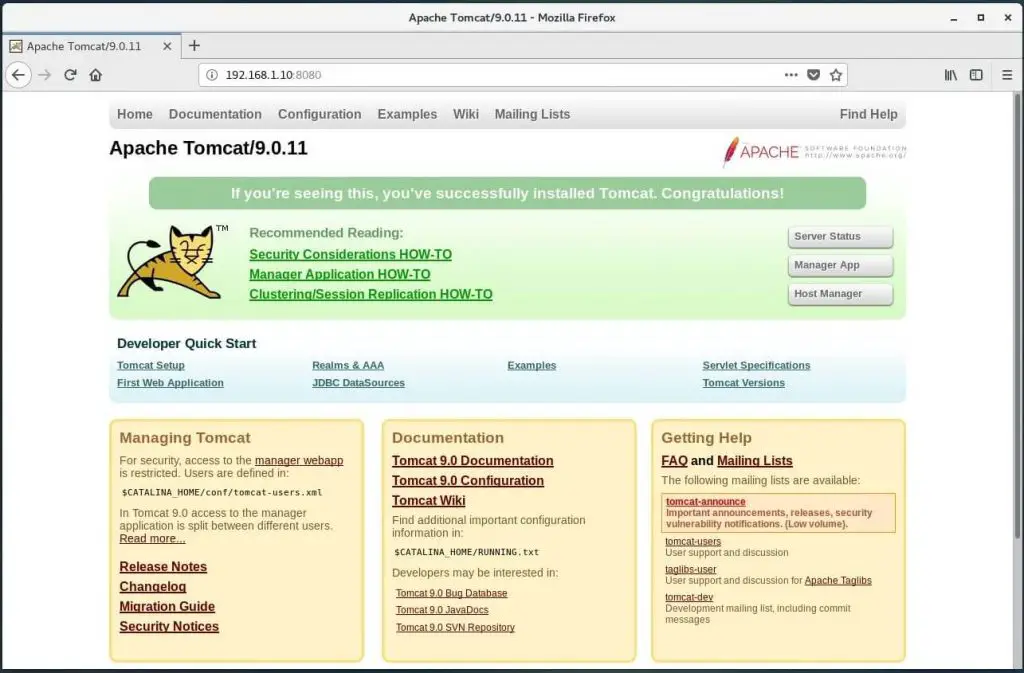
Tomcat 8.5:
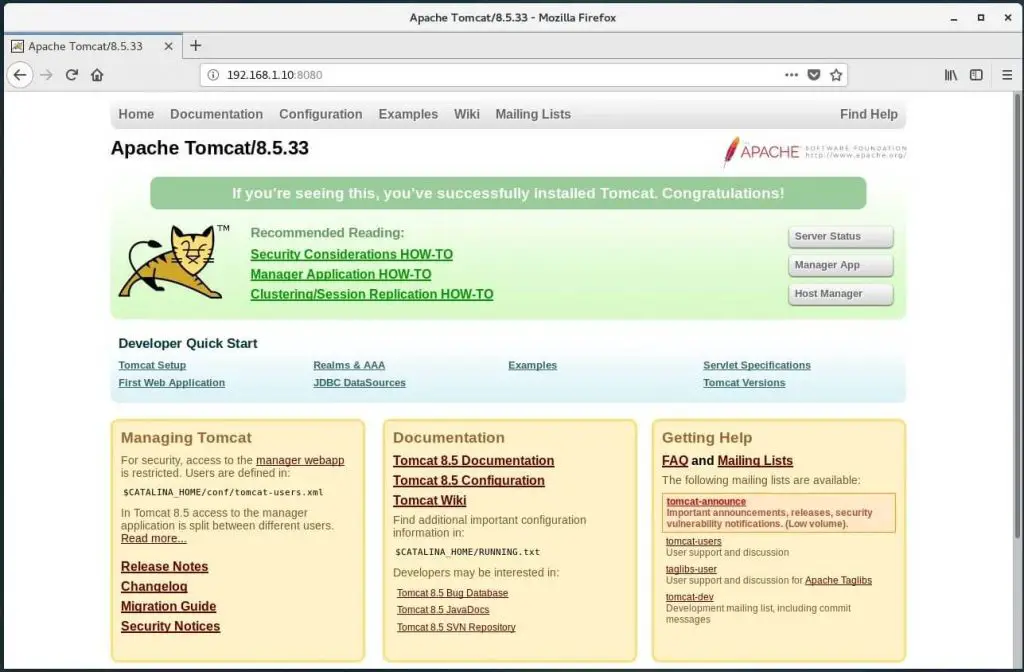
Web Manager: – Login Required. Username: admin, Password: tomcat
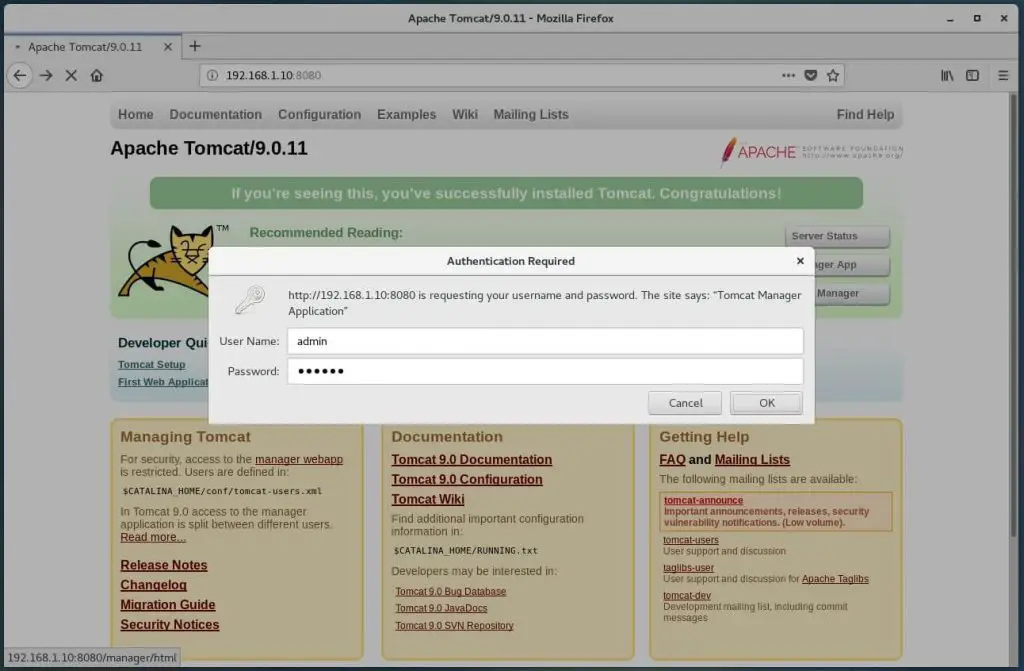
Here, you can deploy a new application, deploy an application in a specified context, start, stop, reload, and un-deploy an application.
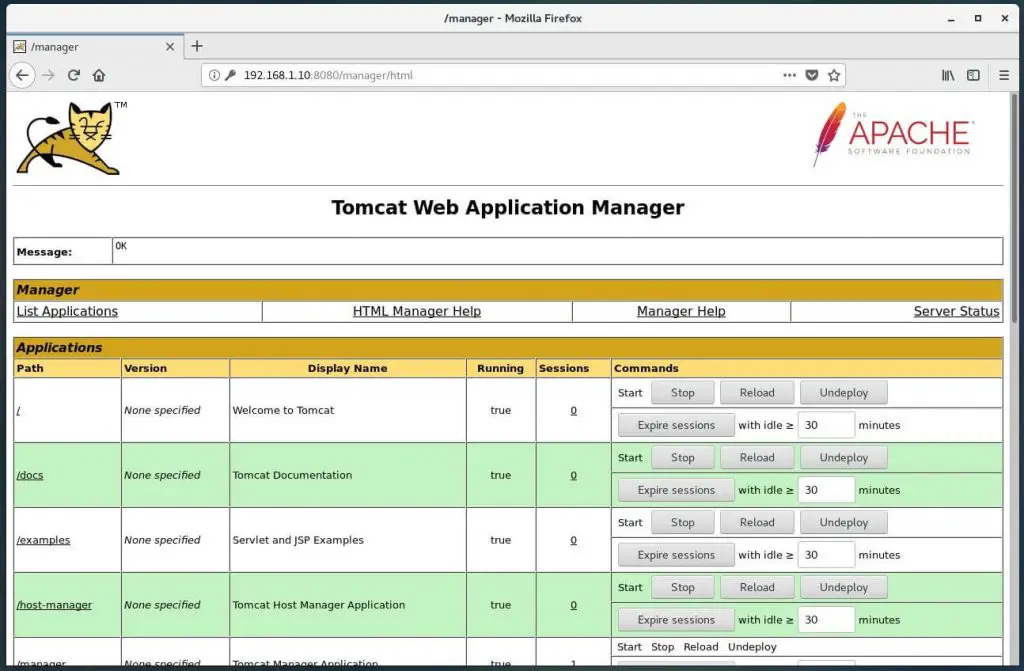
Also, you can check the Tomcat server status.
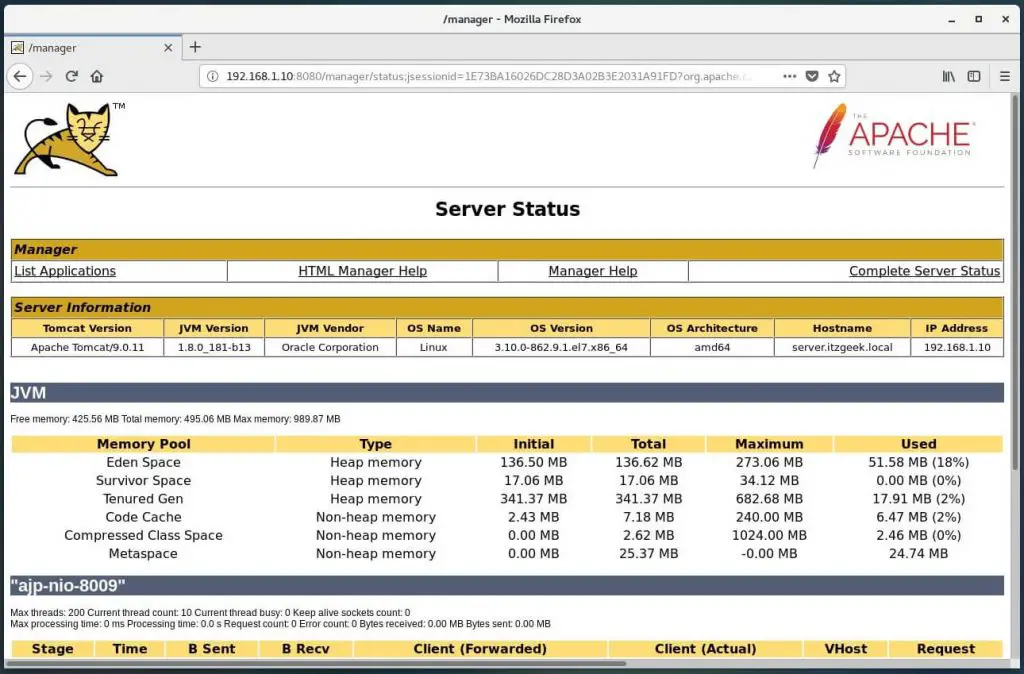
Host Manager: – Login Required. Username: admin, Password: tomcat
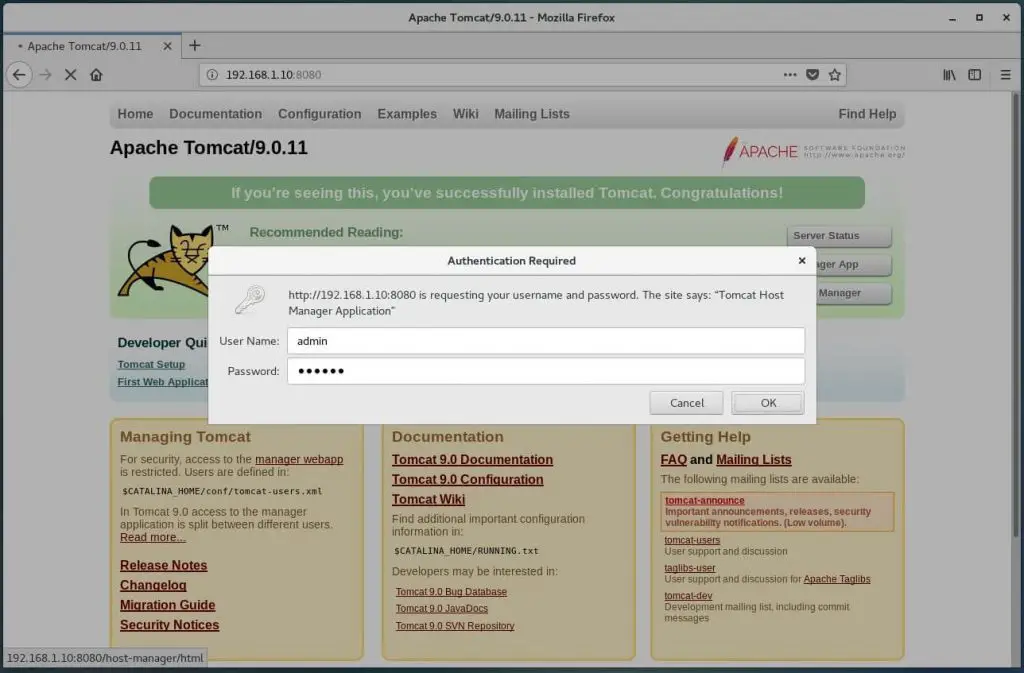
Here, you can manage virtual hosts of Tomcat.
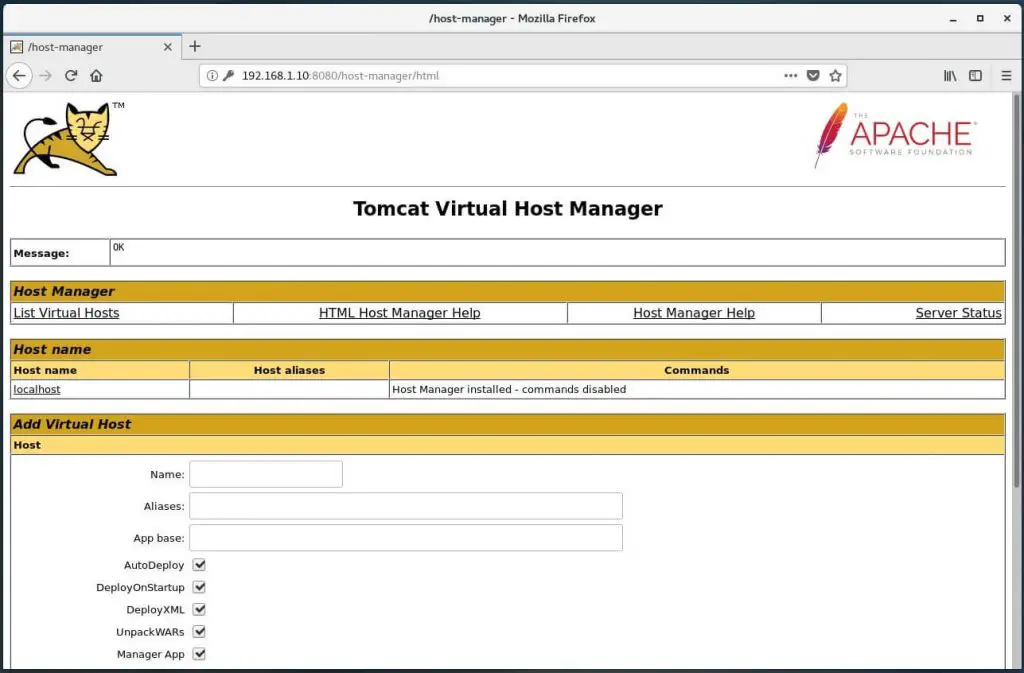
That’s All.
